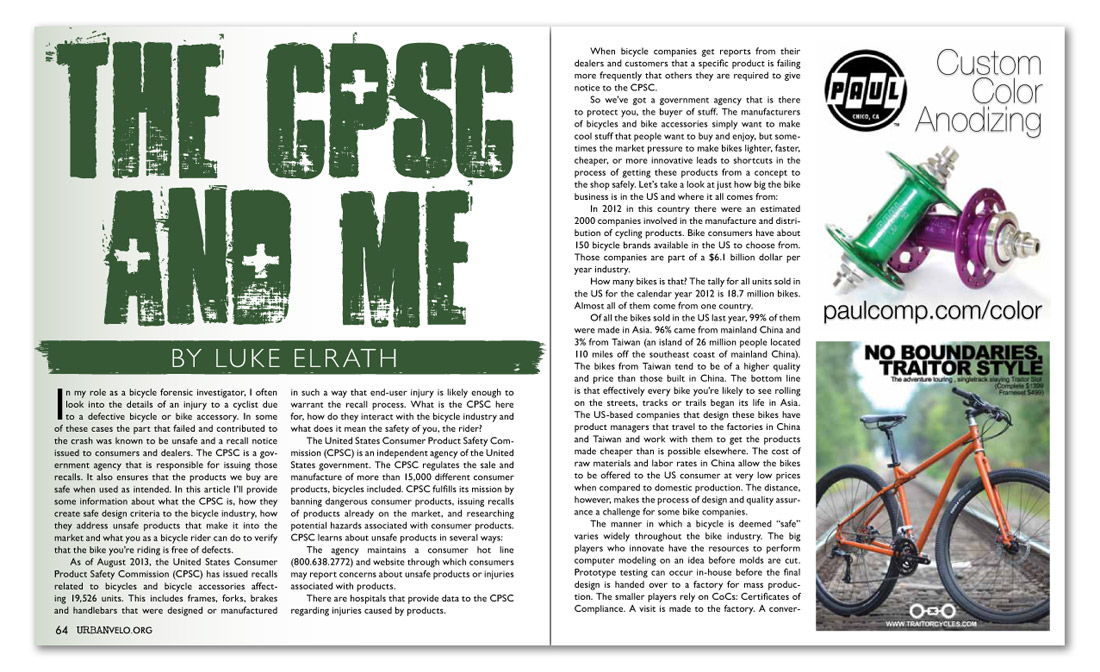


The CPSC And Me
Luke Elrath
In my role as a bicycle forensic investigator, I often look into the details of an injury to a cyclist due to a defective bicycle or bike accessory. In some of these cases the part that failed and contributed to the crash was known to be unsafe and a recall notice issued to consumers and dealers. The CPSC is a government agency that is responsible for issuing those recalls. It also ensures that the products we buy are safe when used as intended. In this article I’ll provide some information about what the CPSC is, how they create safe design criteria to the bicycle industry, how they address unsafe products that make it into the market and what you as a bicycle rider can do to verify that the bike you’re riding is free of defects.
As of August 2013, the United States Consumer Product Safety Commission (CPSC) has issued recalls related to bicycles and bicycle accessories affecting 19,526 units. This includes frames, forks, brakes and handlebars that were designed or manufactured in such a way that end-user injury is likely enough to warrant the recall process. What is the CPSC here for, how do they interact with the bicycle industry and what does it mean the safety of you, the rider?
The United States Consumer Product Safety Commission (CPSC) is an independent agency of the United States government. The CPSC regulates the sale and manufacture of more than 15,000 different consumer products, bicycles included. CPSC fulfills its mission by banning dangerous consumer products, issuing recalls of products already on the market, and researching potential hazards associated with consumer products. CPSC learns about unsafe products in several ways:
The agency maintains a consumer hot line (800.638.2772) and website through which consumers may report concerns about unsafe products or injuries associated with products.
There are hospitals that provide data to the CPSC regarding injuries caused by products.
When bicycle companies get reports from their dealers and customers that a specific product is failing more frequently that others they are required to give notice to the CPSC.
So we’ve got a government agency that is there to protect you, the buyer of stuff. The manufacturers of bicycles and bike accessories simply want to make cool stuff that people want to buy and enjoy, but sometimes the market pressure to make bikes lighter, faster, cheaper, or more innovative leads to shortcuts in the process of getting these products from a concept to the shop safely. Let’s take a look at just how big the bike business is in the US and where it all comes from:
In 2012 in this country there were an estimated 2000 companies involved in the manufacture and distribution of cycling products. Bike consumers have about 150 bicycle brands available in the US to choose from. Those companies are part of a $6.1 billion dollar per year industry.
How many bikes is that? The tally for all units sold in the US for the calendar year 2012 is 18.7 million bikes. Almost all of them come from one country.
Of all the bikes sold in the US last year, 99% of them were made in Asia. 96% came from mainland China and 3% from Taiwan (an island of 26 million people located 110 miles off the southeast coast of mainland China). The bikes from Taiwan tend to be of a higher quality and price than those built in China. The bottom line is that effectively every bike you’re likely to see rolling on the streets, tracks or trails began its life in Asia. The US-based companies that design these bikes have product managers that travel to the factories in China and Taiwan and work with them to get the products made cheaper than is possible elsewhere. The cost of raw materials and labor rates in China allow the bikes to be offered to the US consumer at very low prices when compared to domestic production. The distance, however, makes the process of design and quality assurance a challenge for some bike companies.
The manner in which a bicycle is deemed “safe” varies widely throughout the bike industry. The big players who innovate have the resources to perform computer modeling on an idea before molds are cut. Prototype testing can occur in-house before the final design is handed over to a factory for mass production. The smaller players rely on CoCs: Certificates of Compliance. A visit is made to the factory. A conver-